A Spark of Potential in Amazon’s Fire Phone
Wait, what? Amazon is now making smartphones? Isn’t it an Internet bookstore or something?
Yes, indeed. But in its quest to be “the everything store” — or, more precisely, its quest to be Apple or Samsung — Amazon has followed up its Fire tablet and Fire TV box with the Fire smartphone.
“Wait, we’ve already got the iPhone, Android phones, the Windows Phone, and even a few BlackBerry phones still kicking around,” the whole world thought at once. “Do we really need another cellphone platform, with its own
operating system, apps, and accessories?”
operating system, apps, and accessories?”
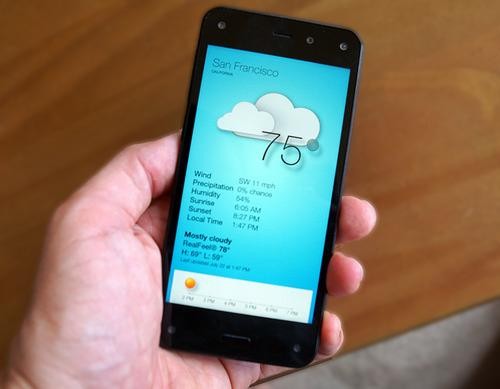
If Amazon thinks so, the Fire phone had better do some amazing tricks. It had better stomp the competition. It had better be pretty persuasive to make you turn your back on the 1 million apps and features of more established phones.
The six-camera phoneThe Fire phone has a 4.7-inch screen, lovely but lower resolution than the latest from Apple, Samsung, and others (although you can’t actually see much difference). The front and back of the phone are hard-to-break Gorilla Glass, and the edges are rubberized. It feels nice — heavy and substantial — but not as slim, svelte, or sculpted as other premiere phones.

The buzziest new feature is what Amazon calls Dynamic Perspective. The four front corners of the phone have cameras.
Together, they track your face as it moves; in some apps, the angle of what you’re seeing shifts in a startling and very cool way. You notice it most on the Lock screen, where you get a choice of hyper-3D scenes:

This perspective business isn’t an especially big step forward in efficiency or usefulness. It’s neat-looking on the Lock screen, and it’s handy in certain games written just for this phone. But otherwise, man, that’s a lot of cameras for a special effect.
The new smartphone gestures are much more successful. Many of Amazon’s apps (the Home screen, Calendar, Messages, Mail, browser, Maps, and so on) are designed with info-panels that flip into view from the left and right sides of the main screen, like this:
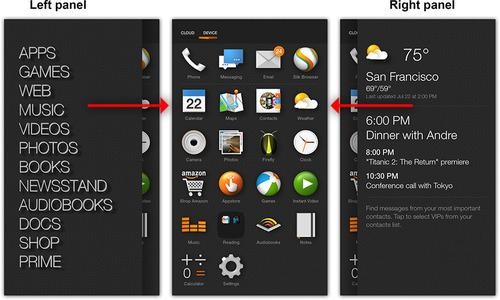
The left panel tends to be a menu; the right one is usually details.
Anyway, you open and close these panels with a quick tip of the phone’s edge (as shown in my video above). You can also use your finger, but the gestures are more convenient.
Another one: If you sharply rotate the phone — fling its top along a short arc — you open the quick settings panel (Airplane mode, WiFi, Bluetooth, brightness, and so on). This, too, quickly becomes second nature.
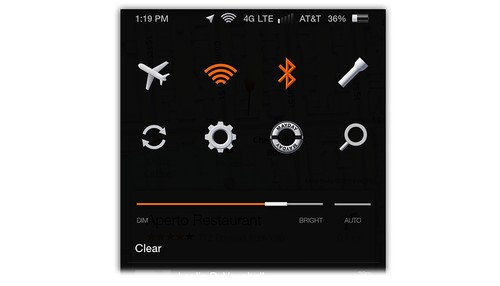
Finally, you can tip the phone to scroll a webpage, as on some other smartphones. (Weird that there’s no one-handed gesture available for turning pages in Amazon’s own Kindle ebook app.)
These gestures rely on the accelerometer (tilt sensor) as well as the four perspective cameras; so, technically, maybe any phone company could add these gestures. Here’s hoping that they do.
MaydayAmazon is rightly proud of its Mayday feature, which began life on its color Kindle tablets. You tap a button when you need help with your Fire phone — and after a few seconds of connecting, you’re seeing live video of an Amazon tech-support person in a 1-inch floating window. The video is one-way; the rep can’t see you (although he can see what’s on your phone’s screen).
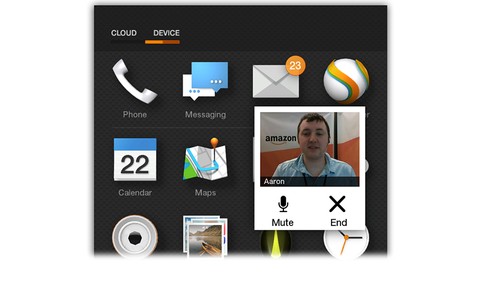
My Mayday reps were uniformly friendly and eager to help. What they weren’t, though, is always correct. In three out of my four calls, they simply gave me incorrect answers. (One, for example, maintained that you can open apps by voice — “Open Calendar” — when, in fact, you can’t. Amazon says that’s coming soon.)
But since I did all my testing before the phone even came out, I’ll cut them some slack. If you have a good Internet connection, it’s a truly great feature, one that nobody else will offer anytime soon.
FireflyThe left side of the phone offers the usual volume up/down keys as well as a dedicated Camera button (a quick press opens the Camera app and also acts as a shutter).
But if you hold down the Camera button, you open another Amazon-exclusive feature, called Firefly.
It recognizes things. Things like products in their packages (100 million of them — food, household goods, books, DVDs, and so on), bar codes, Web addresses, email addresses, and phone numbers.
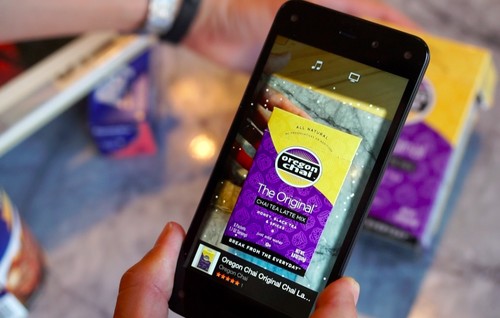
Special buttons switch into a glorified Shazam mode: The phone listens for music playing (it can recognize 35 million songs), movies or TV shows playing right now (250,000), or live TV channels (160). If the recognized show is one that Amazon offers for sale, it even knows where you are in the show, and offers its X-Ray feature (a page of details about the actors currently on the screen).

The product-recognition has been done before on other phones (the Google Goggles feature, Amazon’s own app for iPhone or Android). But those apps don’t do the recognizing nearly as well or as comprehensively, and they don’t recognize nearly as many kinds of things.
Since the I found it! screen offers a Buy on Amazon button, the cynical might describe Firefly as little more than a funnel to get you to buy more stuff from Amazon. (Maybe that’s one reason Firefly can’t recognize store brands — anything exclusive to Walgreens, Whole Foods, Trader Joe’s, and so on.)
But the text-recognition feature is phenomenal. Point the phone at some poster, business card, flier, catalog, whatever — it instantly recognizes any phone numbers, email addresses, or Web addresses it sees. One more tap calls the number, opens the webpage, or preaddresses an email. It’s a great time-saver.

The app situationDeep inside, the Fire phone runs Android — but Amazon has changed it beyond recognition. This, for example, is the Home screen:
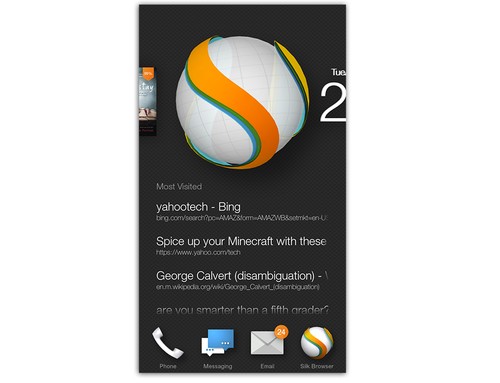
That’s the Carousel. You swipe those jumbo icons horizontally; they represent apps you’ve had open recently or pinned there for quick access. Below each, you see related material — recent email, upcoming calendar appointments, and so on.
It’s not very space-efficient, but it’s extremely easy to figure out, and the “related items” list is a good, fresh idea. Besides: Another press of the Home button opens a more traditional screen of app icons, which you can put into folders as usual.

The biggest problem with the Carousel is that its icons are unlabeled. Quick — what app is this?

Amazon says it might add a label option later.
Despite its Android roots, the Fire phone can’t run standard Android phone apps. Instead, apps must be specially created for the Fire phone.
Fortunately, 185,000 of them are already available (it helps that many Fire tablet apps run fine on the phone). Most of the biggies are there: Facebook, Twitter, YouTube, Camera+, WhatsApp, Angry Birds and spinoffs, Tinder, Waze, Uber, Instagram, Nest, HBO GO, Netflix, Jenga, Pinterest, Dumb Ways to Die, 2048, Temple Run, DragonVale, Flight Track, Vine, Cut the Rope, Shazam, SoundCloud, Viber, Yahoo Weather, Chrome, and Skype.
I found only a few popular apps that aren’t available, like Snapchat, Yahoo News Digest, and GodFinger.
Amazon says more are coming. But a few biggies will probably never come to the Fire phone: those from Google (Google Earth, Google Maps) and Apple (Pages, Numbers, iMovie).
Reducing its dependence on those phone-OS companies is the wholepoint of the Fire phone, so Amazon is clearly willing to burn some bridges. (You can subscribe easily to your Google calendar and contacts, but switching from Apple’s iCloud service is far more complicated.)
Ordinarily, any phone that doesn’t have Google Maps — one of the best apps ever written — wouldn’t be worth considering. But Amazon has gone to the extraordinary step of building its own new Maps app.
Well, not completely new; it’s built on Nokia’s very good HERE Maps database. (“But it’s our own rendering, cartography, and map canvas,” an Amazon product manager told me.) So the Fire phone won’t repeat the disastrous problems of the original Apple Maps.

Amazon’s Maps app is a design copycat of Google Maps, almost down to the pixel, but it’s not as good. It offers driving, walking, and public-transportation directions but no bike guidance. It offers integrated Yelp reviews of restaurants but doesn’t have Google’s amazing Street View photography. It doesn’t tell you which lane to get into for the next turn, and it doesn’t let you download maps for use when you don’t have (or can’t afford) an Internet connection.
And it doesn’t rotate; you have to use it with the phone upright.
The cameraThe camera on the back takes 13-megapixel photos — as though that means anything. How many pixels make up a photo says almost nothingabout the quality of the photo.
Fortunately, the pictures are quite good. Maybe a little darker than from other phones, but nice:
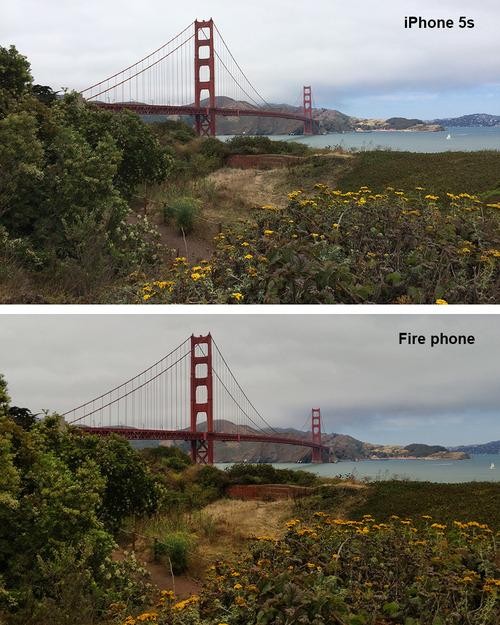

In other ways, though, the camera is heartbreaking. It takes a long time to focus — and sometimes it never does:

The panorama mode needs some work, too, no matter how smoothly and slowly you move the phone:

The value propositionIf you choose a Fire phone instead of one of the more established phone types, you miss out on a few other standard features:
• Siri. On the Fire phone, you can dictate text and issue commands to call, email, or text. But Siri can do so, so much more for you: “Set my alarm for 7:30,” “Open Maps,” “Make my screen brighter,” “Move my Thursday lunch to Friday at 3 p.m.,” “Set a timer for 5 minutes,” “Make a note to water the plants,” “Are there any good Italian restaurants nearby?” “Tweet that I just stubbed both toes simultaneously,” “Who’s in first place in the NFL?” “What time is 22 Jump Street showing tonight?” … and on and on. Next to Siri, the Fire phone’s speech recognition looks like a kindergartener.
(More is coming, Amazon says.)
• Wireless fitness bands. Incredibly, the Fire doesn’t offer Bluetooth LE (Bluetooth 4.0), which allows wearable gadgets to communicate without draining your battery. So you can’t use the Fitbit Force band, the UP24, Garmin Vívofit, Misfit Shine, or other popular wireless wearables.
(Bluetooth LE is built in, Amazon says, but it will take a software upgrade to enable it.)
• Do Not Disturb. You can silence the Fire phone for three hours — handy when you’re entering a movie. But there’s no way to tell it to turn off buzzing and ringing during certain hours each night, like when you’re asleep.
• Ecosystems. There’s no universe of cases, docks, car adapters, and other hardware accessories for a brand-new phone. You’ve been warned.
So there are lots of reasons not to buy the Fire phone. (And don’t forget that it’s AT&T only; check your coverage maps.)
In fact, you could safely ignore the Fire completely if it didn’t have a huge stealth feature: value.
• Twice the storage. The phone costs $200 with a contract, same as the top phones from Apple, Samsung, or HTC. But there’s a big difference: You’re getting a 32-gigabyte Amazon phone — twice the storage of the other companies.
• A year of Amazon Prime. Prime is Amazon’s amazing $100-a-year deal. It gets you thousands of free streaming movies, TV shows, and songs; free ebook lending for a Kindle (or Fire phone); free two-day shipping; and various other perks. It’s a great deal — and yours free if you buy a Fire phone.
• Unlimited free photo storage. You can opt to have every picture and video you take auto-stored on Amazon.com. Unlimited, free. From there, you can download them to any computer, phone, or tablet (although only one at a time).
Not quite on fireThe 1.0 Fire phone is missing some important features, but then again so were the 1.0 iPhones, Android phones, and even Windows phones. Funny thing about software: You can keep working on it even after you’ve sold it.
For now, the Fire might be a good first smartphone for a non-techie; it’s a good economic deal, and the uncluttered software is easy to navigate.
For anyone more experienced, the Fire phone is a phone to watch, not to buy. If we know one thing about Amazon, it’s that it always underbakes its 1.0 devices — but that it’s a deep-pocketed, deeply driven company that’s determined to be a contender.

No comments:
Post a Comment